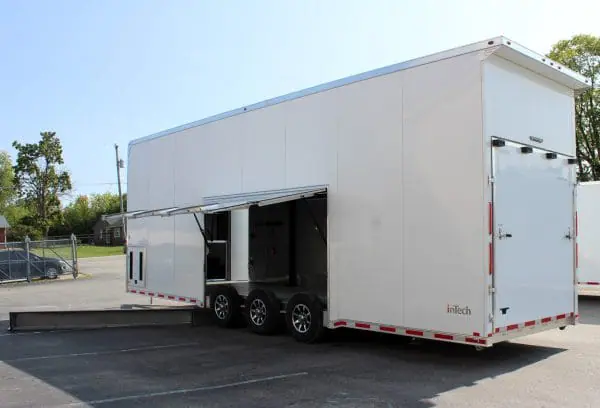In the world of transportation and logistics, stacker trailers have become indispensable tools for maximizing space and enhancing efficiency. Designed to optimize cargo space and streamline operations, stacker trailers serve various industries, from automotive to logistics. This article delves into the features and benefits of stacker trailers, exploring how they can transform your hauling operations. We will also look at key considerations for choosing the right stacker trailer and maintaining it to ensure long-term success.
What is a Stacker Trailer?
A stacker trailer is a specialized type of trailer designed to maximize cargo space by using vertical stacking techniques. Unlike conventional flatbed or enclosed trailers, stacker trailers feature multiple levels or tiers, allowing for the stacking of cargo in a way that optimizes the available space. This design is particularly useful for transporting items that can be safely stacked, such as vehicles, machinery, or other bulk goods.
Key features that set stacker trailers apart include adjustable ramps, lift systems, and customizable interior configurations. These elements enable users to efficiently load and unload goods while ensuring that the cargo remains secure throughout transit. Stacker trailers are used in various industries, including automotive racing, where they transport multiple vehicles and logistics, where they facilitate the efficient movement of large quantities of goods. Find more information at https://www.milltrailers.com/product-category/stacker-car-trailers/.
Types of Stacker Trailers
Stacker trailers come in several types, each designed to meet specific hauling needs. Standard stacker trailers are the most common, featuring a basic design with fixed tiers or levels. These trailers are often used for transporting vehicles or other stackable items where the cargo does not require special handling.
Customized stacker trailers offer tailored solutions for unique hauling requirements. Manufacturers can modify these trailers to include additional features such as extra levels, specialized lift systems, or enhanced security measures. This customization allows businesses to address specific challenges in their operations, making stacker trailers versatile tools for various applications.
Enclosed stacker trailers protect from the elements, ensuring that cargo remains safe and undamaged during transit. This type is ideal for valuable or sensitive items that require a controlled environment. On the other hand, open stacker trailers are often used for bulk goods or items that can withstand exposure to weather conditions. Each type has its advantages, and the choice between enclosed and open stacker trailers depends on the nature of the cargo and the specific needs of the operation.
Benefits of Using Stacker Trailers
The advantages of using stacker trailers are substantial, particularly when it comes to maximizing space and enhancing efficiency. One of the primary benefits is the ability to optimize cargo storage. By utilizing vertical space, stacker trailers allow for more efficient use of the trailer’s length and width. This means that businesses can transport a greater volume of goods without increasing the size of their fleet, leading to cost savings and improved operational efficiency.
Stacker trailers also streamline loading and unloading processes. The inclusion of ramps and lift systems reduces the time and effort required to handle cargo. These features enable quick and easy access to different levels of the trailer, allowing for faster turnaround times and reduced labour costs. Additionally, stacker trailers can help minimize transportation costs by increasing the amount of cargo that can be hauled in a single trip, thereby reducing the need for multiple trips.
Safety is another critical benefit of stacker trailers. The design of these trailers ensures that cargo is securely held in place, reducing the risk of damage during transit. By providing stable storage solutions, stacker trailers help protect goods from shifting or falling, which can be particularly important for delicate or high-value items. This added security contributes to overall safety and reduces the likelihood of accidents or losses.
Design Considerations for Stacker Trailers
When selecting a stacker trailer, several design considerations must be taken into account to ensure that it meets specific hauling needs. Load capacity and weight distribution are crucial factors, as they determine the trailer’s ability to handle different types of cargo. Understanding the weight limits and ensuring that the trailer is used within these limits helps maintain safety and performance.
Ramp and lift systems are essential components of stacker trailers, facilitating the loading and unloading of cargo. Various types of ramps and lift mechanisms are available, including hydraulic lifts and manual ramps. The choice of system depends on factors such as the type of cargo, the frequency of use, and the available space for manoeuvring the trailer.
Material and build quality also play a significant role in the durability and performance of stacker trailers. Choosing high-quality materials ensures that the trailer can withstand the rigours of frequent use and various environmental conditions. The build quality affects the trailer’s overall strength and longevity, making it important to select a trailer that offers both durability and reliability.
Conclusion
Stacker trailers represent a valuable investment for businesses seeking to maximize space and efficiency in their hauling operations. With their ability to optimize cargo storage, streamline loading and unloading processes, and enhance safety, stacker trailers offer numerous benefits that can significantly impact operational efficiency and cost-effectiveness. By carefully considering design factors, selecting the right trailer, and maintaining it properly, businesses can ensure that their stacker trailer provides long-term value and performance.

